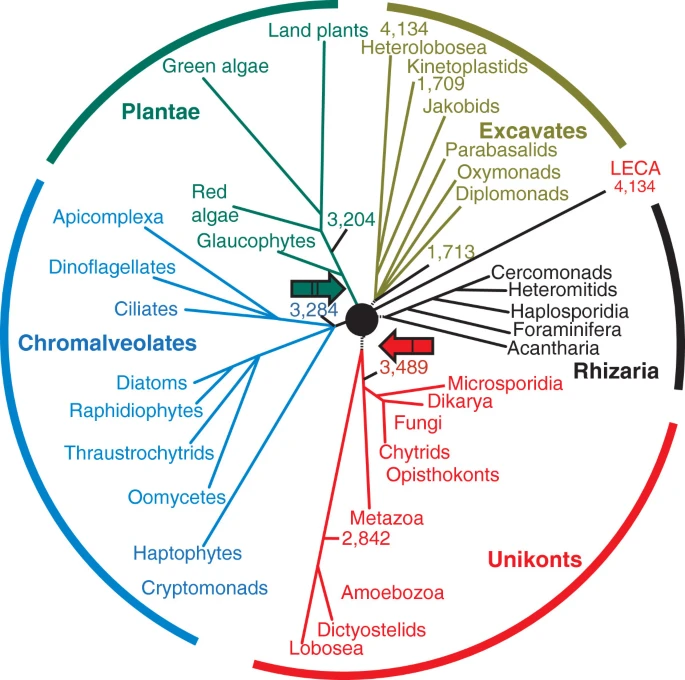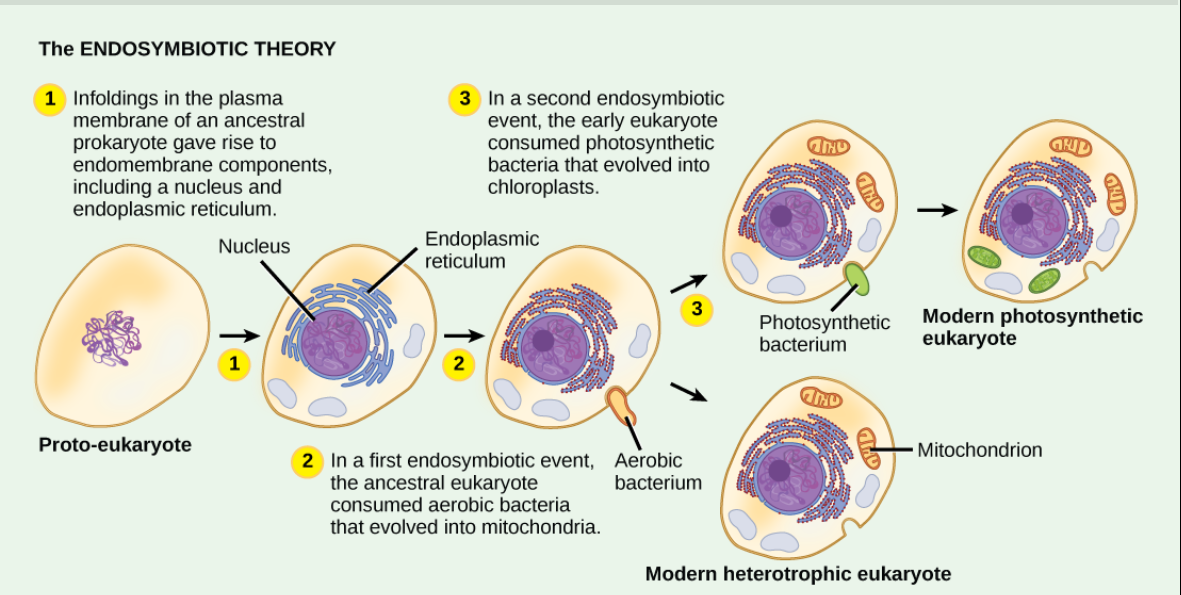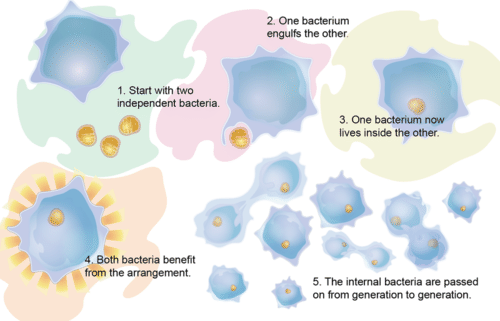Eukaryote Evolution Study Guide
Introduction:
Living things are classified under three major groups, namely Archaea, Bacteria, and Eukarya. The first two are classified under prokaryotes, while the third falls under eukaryotes. Very rare fossils have been found, which gives valuable information and helps discern the very first ancestor of each of these classes. The very early fossils that were discovered belonged to bacteria, and are commonly thought to be cyanobacteria.
These fossils are almost 3.5 billion years old, and are invaluable in helping us understand and put pieces of the puzzle together!
What event is thought to have contributed to the evolution of eukaryotes?
Finding the origin of eukaryotic cells and their exact timeline can be quite challenging when it comes to evolutionary biology. Regarding eukaryotic and prokaryotic cells, there is a massive difference in the organizational complexity — eukaryotic cells consist of intracellular compartmentalization, whereas prokaryotic cells do not. A eukaryotic cell is almost 1,000-fold bigger (by volume) than a typical bacterium and has different physical functions.
A complex endomembrane system supports eukaryotic cells and their intracellular compartmentalization. However, the biggest hallmark of a eukaryotic cell would be the mitochondria which is absent in even the most complex prokaryotic cell. Observing all this, it can be said that all kinds of eukaryotes ultimately came from the last eukaryotic ancestor, LECA. It is believed mitochondria evolved from LECA.
Cross-talking signaling networks diversely support the intracellular compartmentalization of the eukaryotic cell. The major one would be kinase-phosphatase machinery that assists in protein regulation. The ubiquitin network supports protein turnover, translation by microRNAs regulation.
Endosymbiotic Theory
With the development of cell biology, it was precisely clear that mitochondria were the cell organelles that supported ATP production using aerobic respiration. Lynn Margulis came up with the endosymbiotic theory. The endosymbiotic theory suggests that some organelles cell organelles, such as mitochondria and plastids, were once aerobic bacteria (prokaryote) ingested by a large anaerobic bacteria (prokaryote). Before being ingested by anaerobic bacteria, the aerobic bacteria were initially free-living prokaryotes.
Margulis suggested that mitochondrial endosymbiosis initiated the evolution of the eukaryotic cell.
At first, this theory met a lot of resistance; however, at present, this is the most widely accepted theory that has helped uncover how mitochondria and chloroplasts arose in eukaryotic cells. It is now deduced that many of the replication processes are closely related to Archaea, while the metabolic organelles alongside genes that support energy-harvesting processes come from bacteria.
Mitochondria
- The basic feature that separates the eukaryotes from prokaryotes would be the presence of mitochondria.
- A mitochondria-containing cell could contain not just one but even thousands of mitochondria depending on the energy consumption level of that cell. Mitochondria could measure anywhere between 1 to 10 micrometers and be worm-shaped, intricate, and even ovoid.
- It is important to remember that mitochondria cannot exist outside the cell wall.
- As aerobic prokaryotes evolved, evidence has been found that suggests a membrane compartmentalized ancestral wall had engulfed an aerobic prokaryotic.
- This gives the cell the ability to use oxygen to release energy from the present nutrients.
- Most of the mitochondria are shaped very similar to alpha-proteobacteria.
- The inner walls of mitochondria are extensive and come with infoldings known as cristae.
- The cell-matrix alongside the inner membrane consists of enzymes needed for aerobic respiration.
- Mitochondria almost undergo a process similar to binary fission.
- However, even though they are a part of the eukaryotic cell, they reproduce independently and come with their own circular DNA chromosome that is stabilized by attaching to the inner membrane.
- Like in prokaryotes, mitochondria also consist of ribosomes and transfer RNAs.
- Besides the aerobic generation of ATP, mitochondria are involved in other functions, including generating iron and sulfur clusters, considered crucial enzyme cofactors.
Plastids
- Some eukaryotes are photosynthetic.
- This is another organelle like the mitochondria present within the cell. Cells that undergo photosynthesis contain chlorophyll and other such pigments, which help harvest energy from light.
- Plastids that are involved with photosynthesis are called chloroplasts. Similar to mitochondria, you can observe endosymbiotic origin for chloroplasts as well.
- Plastids are known to have undergone two endosymbiosis processes, and not all plastids of eukaryotes are derived from the primary one.
- Some major algae groups became photosynthetic after undergoing secondary endosymbiosis.
- Secondary endosymbiosis is a reiteration process where a eukaryote already containing an endosymbiont undergoes secondary endosymbiosis within another eukaryote.
- Plastids are known to come from cyanobacteria that were found with the aerobic, heterotrophic eukaryote cells. What are cyanobacteria? They are gram-negative bacteria that come with all the conventional structures of the group. Along with the presence of thylakoids, they also have a peptidoglycan wall and a lipopolysaccharide layer.
Conclusion:
- Living cells fall under Archaea, Bacteria, and Eukarya.
- The oldest eukaryotic fossil is about 2 billion years old, and the ones older than this are prokaryotes.
- The last eukaryote ancestor had cells with nuclei and also divided mitotically. The DNA was associated with a cytoskeleton, histones alongside an endomembrane system.
- The phenomenon of endosymbiosis largely contributed to eukaryote biodiversity during evolution.
- Eukaryotic cells are aerobic due to the presence of mitochondria.
- Some even come with plastids which are photosynthesizing in nature.
- It is believed mitochondria evolved from LECA.
- Eukaryotes of today are diverse in nature, shapes, and life cycles.
- Mitochondria are involved in other functions that include generating iron and sulfur clusters.
FAQs:
1. How did eukaryotes evolve?
The first eukaryotic cell developed due to the symbiotic relationship between two prokaryotic cells.
2. What evolved before eukaryotes?
Prokaryotic life evolved before eukaryotic life.
3. What was the first eukaryote?
Protists were the first eukaryotes.
4. What kind of organisms are eukaryotes?
Eukaryotes are cells that come with membrane-bound organelles and a nucleus, unlike prokaryotes.
We hope you enjoyed studying this lesson and learned something cool about the Eukaryote Evolution! Join our Discord community to get any questions you may have answered and to engage with other students just like you! Don’t forget to download our App to experience our fun, VR classrooms – we promise, it makes studying much more fun! 😎
Sources:
- Eukaryote Evolution. https://flexbooks.ck12.org/cbook/ck-12-biology-flexbook-2.0/section/5.5/primary/lesson/evolution-of-eukaryotes-bio/ Accessed 13 Dec, 2021.
- The origin and early evolution of eukaryotes in the light of phylogenomics. https://genomebiology.biomedcentral.com/articles/10.1186/gb-2010-11-5-209 Accessed 13 Dec, 2021.
- Symbiosis and evolution: at the origin of the eukaryotic cell. https://www.encyclopedie-environnement.org/en/life/symbiosis-and-evolution-origin-eukaryotic-cell/ Accessed 13 Dec, 2021.
- Eukaryotic Origins. https://courses.lumenlearning.com/suny-biology1/chapter/eukaryotic-origins/ Accessed 13 Dec, 2021.
- Eukaryotes and their Origins. https://organismalbio.biosci.gatech.edu/biodiversity/eukaryotes-and-their-origins/ Accessed 13 Dec, 2021.



